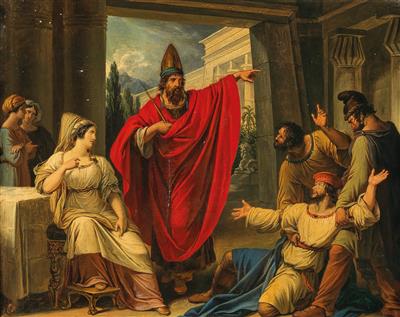Anton Petter

(Vienna 1781-1858)
King Ahasuerus Sentencing the High Priest Haman to Death in the Presence of Esther, oil on canvas, 42.5 x 53 cm, framed (frame damaged), (KN)
Provenance:
Private Collection Austria.
In the present work, the Viennese history painter Anton Petter takes a scene from the Book of Esther in the Old Testament. The Persian king Ahasuerus separated from his first wife and married the young Esther, whose Jewish family background was unknown to him. Esther had been raised by a relative, the court official Mordecai, who came into conflict with the Persian chief priest Haman. Mordecai had refused Haman the proskynesis (‘prostration’), a gesture of adoration that originated in cultic contexts and was usually reserved for statues and gods. As a Jew and thus a monotheist, Mordecai understandably refused to worship Haman. In revenge, Haman plans a plot against the Jewish population in the Persian Empire, which Esther is able to thwart. During a banquet, she makes a flaming speech on behalf of her people and accuses Haman of scheming. Her words convince King Ahasuerus, who condemns Haman to death in front of everyone. It is precisely this moment of the narrative that Petter picks out here. Whilst Esther’s triumph is restrained, Haman oozes despair. The figures are remarkable both in their compositional and spatial execution, and harmoniously contextualised in an ancient Persian scenery, proving Petter’s special talent as a history painter. A much larger version of this subject by Petter’s hand is preserved in the Belvedere collection under inventory number 6283. (KN)
15.09.2021 - 15:09
- Stima:
-
EUR 1.200,- a EUR 1.600,-
Anton Petter
(Vienna 1781-1858)
King Ahasuerus Sentencing the High Priest Haman to Death in the Presence of Esther, oil on canvas, 42.5 x 53 cm, framed (frame damaged), (KN)
Provenance:
Private Collection Austria.
In the present work, the Viennese history painter Anton Petter takes a scene from the Book of Esther in the Old Testament. The Persian king Ahasuerus separated from his first wife and married the young Esther, whose Jewish family background was unknown to him. Esther had been raised by a relative, the court official Mordecai, who came into conflict with the Persian chief priest Haman. Mordecai had refused Haman the proskynesis (‘prostration’), a gesture of adoration that originated in cultic contexts and was usually reserved for statues and gods. As a Jew and thus a monotheist, Mordecai understandably refused to worship Haman. In revenge, Haman plans a plot against the Jewish population in the Persian Empire, which Esther is able to thwart. During a banquet, she makes a flaming speech on behalf of her people and accuses Haman of scheming. Her words convince King Ahasuerus, who condemns Haman to death in front of everyone. It is precisely this moment of the narrative that Petter picks out here. Whilst Esther’s triumph is restrained, Haman oozes despair. The figures are remarkable both in their compositional and spatial execution, and harmoniously contextualised in an ancient Persian scenery, proving Petter’s special talent as a history painter. A much larger version of this subject by Petter’s hand is preserved in the Belvedere collection under inventory number 6283. (KN)
|
Hotline dell'acquirente
lun-ven: 10.00 - 17.00
kundendienst@dorotheum.at +43 1 515 60 200 |
| Asta: | Dipinti a olio e acquarelli del XIX secolo |
| Tipo d'asta: | Asta online |
| Data: | 15.09.2021 - 15:09 |
| Luogo dell'asta: | Wien | Palais Dorotheum |
| Esposizione: | 08.09. - 15.09.2021 |
